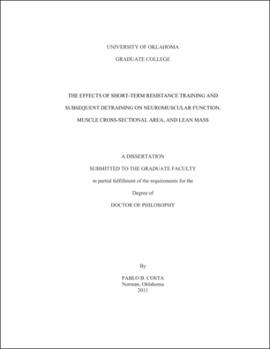| dc.description.abstract | A resistance training program has been the hallmark of exercise and rehabilitation treatment, and the neuromuscular system undergoes numerous adaptations following this type of training intervention. Recently, interest has shifted to short-term resistance training. Short-term resistance training has been shown to increase muscle strength and isokinetic (ISOK) performance after only a few days of training; however, the specific mechanisms of such adaptations to different modes of short-term training have not been fully understood. Therefore, the purpose of this study was to examine and compare the effects of three days of dynamic constant external resistance (DCER) and ISOK training and subsequent detraining on thigh muscle cross-sectional area (TMCSA) and thigh lean mass (TLM), ISOK peak torque (PT), DCER strength, isometric force, surface electromyography (EMG), and surface mechanomyography (MMG) of the leg extensors during maximal leg extension muscle actions, percent voluntary activation (%VA), and the electromechanical delay (EMD). A mixed factorial design was used to examine the effects of three days of short-term resistance training. Thirty-one apparently-healthy untrained men (mean ± SD age = 22.2 ± 4.2 yrs; body mass = 77.9 ± 12.9 kg; height = 173.9 ± 5.4 cm) were randomly assigned to a DCER training group, ISOK training group, or control (CONT) group. Subjects visited the laboratory eight times, the first visit was a familiarization session, the second visit was a pre-training assessment, the subsequent three visits were for training (if assigned to a training group), and the last three visits were the post-training assessments. Testing included assessments of body composition, DCER, ISOK, and isometric strength, EMG, MMG, %VA, and EMD. One training group performed ISOK leg extension exercise and the other performed DCER leg extension exercise for three sets of ten repetitions each of the three days of training. A third group took part in a CONT condition and did not train. Rating of perceived exertion (RPE) was obtained after each training set (set RPE) and after every training session (session RPE). The dependent variables in this study were (a) body mass (BM); (b) body fat percentage (BF%); (c) thigh fat percentage (TF%); (d) thigh lean mass (TLM); (e) thigh muscle cross-sectional area (TMCSA); (f) isokinetic PT; (g) DCER strength; (h) isometric force; (i) EMG; (j) MMG; (k) %VA at 30, 50, 70, and 100% of maximum MVC; (l) EMD; and (m) RPE. No changes in BF%, TLM, or TMCSA were found. However, BM decreased for all groups from pre- to post-training assessment one. There were no changes for ISOK PT, but PT was greater for the right than left leg and at 90°∙s-1 than 180°∙s-1. DCER strength increased from pre- to post-training assessment 1 in both limbs for the DCER group only, and remained elevated during post-training assessments 2 and 3. In addition, DCER strength was higher for the right leg than left leg. No changes were found for isometric strength. Surface EMG amplitude for the rectus femoris and vastus lateralis did not change, but was higher at 180°∙s-1 than 90°∙s-1. Surface EMG for the biceps femoris was higher at post-training assessment 3 than pre-training assessment, post-training assessment 1, and post-training assessment 2. In addition, biceps femoris EMG was higher at 180°∙s-1 than 90°∙s-1. No changes were found for %VA, but increased from 30 to 100% of MVC intensity. Surface MMG amplitude for the rectus femoris and vastus lateralis did not change, but was higher at 180°∙s-1 than 90°∙s-1. No changes were found for EMD. Set RPE did not change over the training sessions, but increased from the first until the last set within all sessions for both training groups. Session RPE did not change over the training sessions. The primary finding of this study was that DCER strength can be increased with three days of training. Another important finding of the current study is that short-term resistance training induces a cross-education effect increasing the strength in the untrained limb. This has important implications for injury rehabilitation, where in the initial period post-injury strength gains on an injured limb can possibly be obtained with short-term contralateral resistance training. Strength gains observed after DCER resistance training were due to an unidentified factor. The findings of the current study may indicate an advantage of DCER over ISOK resistance training programs when conducted over a relatively short period of time. Traditional DCER resistance training appears to be a better and more cost-effective option when rapid increases in strength are desired and a longer amount of time is not available. These findings have important implications in clinical rehabilitation settings, sports injury prevention, as well as in other allied health fields such as physical therapy, occupational therapy, and athletic training. To our knowledge, the current study is the first to demonstrate recently-acquired strength can be maintained for a two-week period in trained and untrained limbs. Therefore, future studies should examine the effects of short-term resistance training on injury prevention and rehabilitation. | |
